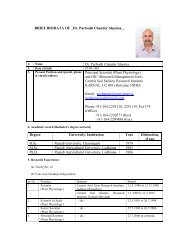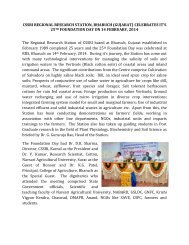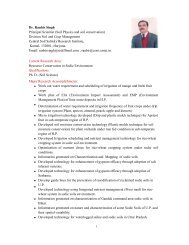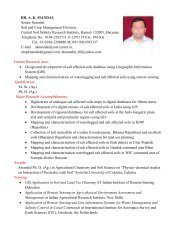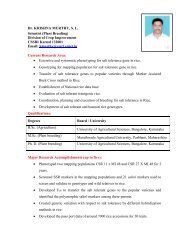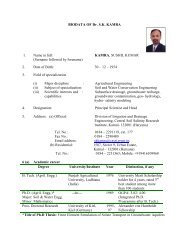Salinity News - CSSRI Karnal
Salinity News - CSSRI Karnal
Salinity News - CSSRI Karnal
You also want an ePaper? Increase the reach of your titles
YUMPU automatically turns print PDFs into web optimized ePapers that Google loves.
SALINITY <strong>News</strong><br />
Vol. 16, No. 2 July-December, 2010<br />
at the initiation and completion of experiments indicated enrichment of<br />
soils with available N, P and K and with moderate increase in organic<br />
carbon suggesting the important role played by the biological sludge in<br />
soil enrichment. The studies hitherto conducted indicated that the use<br />
of biological sludge from fertilizer industries can be a better option for<br />
sustainable management of lands for production of crops like leafy<br />
vegetables, lady’s fi nger and cluster bean. Its use will help in improving<br />
soil properties vis-à-vis supply nutrients for plant growth and yield in<br />
Vertisols.<br />
G. Gururaja Rao, Sanjay Arora, M.K. Khandelwal and Anil R.<br />
Chinchmalatpure<br />
Sustainable Land and Water Management for Enhancing Livelihood Security of Farming Communities of Coastal Region<br />
Agriculture in coastal regions of India is mainly rainfed and mono-cropped,<br />
mostly with traditional rice during monsoon months. Degraded soil (saline<br />
& poorly drained) and saline water, together with climatic adversities,<br />
drainage congestion and acute shortage of good quality irrigation water<br />
contribute to the poor livelihood security and low agricultural productivity. A<br />
research project under NAIP has been implemented in the disadvantaged<br />
coastal regions of Sundarbans (West Bengal) and Tsunami affected Northmid<br />
& South of Andaman islands to alleviate the ill-effects of degraded land<br />
and water for improving productivity, livelihood security and employment<br />
opportunities of rural men and women and their capacity building. The<br />
project was implemented in a consortia mode involving 5 institutions viz.<br />
<strong>CSSRI</strong>, RRS, Canning Town (lead center), Ramkrishna Ashram Krishi<br />
Vigyan Kendra, Nimpith, Central Institute of Brackishwater Aquaculture,<br />
Kakdwip Research Centre, Kakdwip, Central Agricultural Research<br />
Institute, Port Blair and Bidhan Chandra Krishi Viswavidyalaya, Mohanpur.<br />
Various technological interventions of agriculture, animal husbandry and<br />
integrated farming systems have been taken up to enhance the productivity<br />
of the degraded mono-cropped coastal lands and to improve the livelihood<br />
security of the farming communities. A combination of technological actions<br />
has been taken up to reduce soil salinity and its further degradation and<br />
identifi cation and development of various livelihood options.<br />
Under land management component, land shaping techniques like farm<br />
pond, deep furrow & high ridge, shallow furrow & medium ridge and paddycum-fi<br />
sh cultivation were implemented at the farmers’ fi eld for harvesting<br />
of rainwater for diversifi ed crops and integrated crop-fi sh cultivation. Land<br />
shaping techniques improved the drainage congestion of the fi eld locally<br />
and reduced salinity build up due to higher elevation of land in relation to<br />
stored fresh water. Interventions like paddy and fi sh cultivation, multiple and<br />
salt tolerant crop cultivation, nutrient management, mushroom cultivation,<br />
bee keeping and composting, fresh water and brackish water fi sh<br />
cultivation, livestock health management, introduction of improved breeds<br />
of goats/sheep/poultry have also been taken in this project. Farmers were<br />
empowered through various training programmes on different aspects<br />
of land management, crop cultivation and other livelihood opportunities.<br />
There has been a greater interest in land shaping technologies, rain-water<br />
harvesting for irrigation and integrated cultivation of crop and fi sheries<br />
among farmers due to higher returns while women have shown great<br />
interest in mushroom cultivation for improving their livelihoods.<br />
B. K. Bandyopadhyay, D. Burman, S. K. Sarangi, S. Mandal,<br />
K. K. Mahanta, B. Maji and D. K. Sharma<br />
Direct Seeded Rice in Sodic soil<br />
Rice is one of the important staple cereal crops in Uttar Pradesh.<br />
Traditionally, rice is grown by transplanting (TPR) of 4-5 week old<br />
seedlings in puddled soil. The puddling operation helps to reduce the<br />
soil water percolation and weed infestation in the fi eld and also facilitates<br />
the transplanting of rice seedling. On the other hand, puddling destroys<br />
soil aggregates, disperses clay and reduces water transmission pores. In<br />
sodic soil, puddling deteriorates the physical condition of the soil and also<br />
requires lot of water to saturate the soil. This is one of the reason that late<br />
onset of monsoon affect the area under rice cultivation. Also, puddling and<br />
transplanting often make the farmers diffi cult to complete their operation<br />
in time because of labour shortage. In view of these problems, Direct<br />
Seeded Rice (DSR) is emerging as a promising method of rice cultivation<br />
where seeding of rice is done directly by seed drill or manually in furrow<br />
at a depth of 2-3 cm in dry condition or surface seeding after puddling of<br />
fi eld under wet condition. Dry method of seeding is preferred to minimize<br />
the adverse effect of puddling on soil structure, dispersion of clay and<br />
DSR<br />
TPR<br />
hydraulic properties of soil.<br />
For weed control, the fi eld needs two ploughing in the last week of May<br />
and or the spray of weedicide Glyphosate @ 0.05 % in the second or third<br />
week of June. Rice can be sown in last week of June and fi rst week of<br />
3





